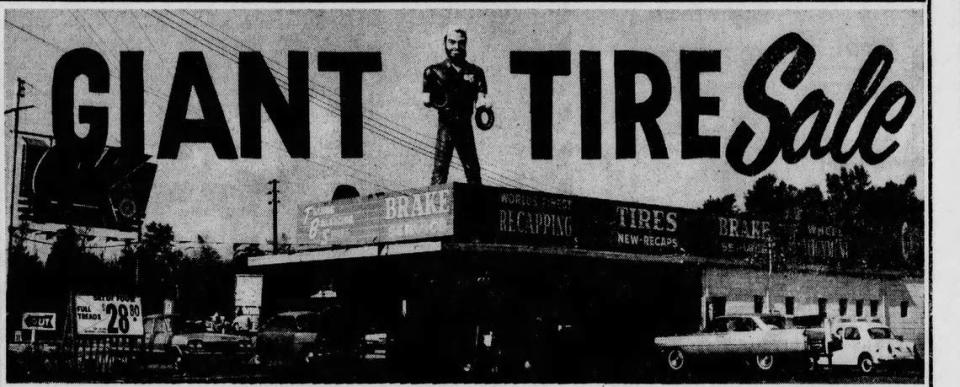A tall Paul Bunyan statue once reigned at Macon car shop. Where is the tire man now?
Finding one 20-foot Muffler Man statue in a community is uncommon, but two? One man has become aware of two of the giant man figurines that once highlighted Macon businesses.
While on the hunt for one 20-foot Muffler Man, former genealogist Dave Distler stumbled across another massive gem that proudly topped a local automotive business in Macon in the 1960s — though the second one isn’t in his possession.
A fiberglass Paul Bunyan statue stood at 1471 Rocky Creek Road, just 10 minutes away from the giant cowboy at the Phillips 66 Gas Station on Hartley Bridge Road.
The find was rather surprising for Distler, who said it was unusual for Macon to have two giants, considering its small population size at the time. Macon did have more than 140,000 inhabitants by 1960, according to the Middle Georgia Regional Library’s reference desk.
How did the 2nd giant get to Macon?
In 1963, Dublin native and long-time Macon resident Warren Raffield opened Raffield’s O.K. Tire Store on Rocky Creek Road in South Macon.
In 1965, he bought the Bunyan muffler man to promote his automotive shop’s limited “giant bargains,” which were often advertised in The Telegraph newspaper, Distler said.

The 20-foot giant became well-known throughout the city for standing on top of the shop in the Pio Nono Plaza Shopping Center, holding tires in its hand and luring customers.
Joel Baker, founder of American Giants, said Raffield’s purchase of the fiberglass giant was significant because it was one of the very first Muffler Man replicas built at the time.
“In 1962, a guy named Bob Prewitt hired someone to make the first fiberglass giants, which were the Paul Bunyan statues,” he said. “Bob sold the mold to International Fiberglass in California, and they were the ones who took the giants and made different versions – cowboys, pirates, Native American chiefs – so people can attract more customers.”
The original Paul Bunyan versions of Muffler Men are the most popular versions being rediscovered around the country, he added.
As for Macon? Well, it’s safe to say the heart of Georgia had the honor of housing at least two versions of these historic landmarks.
Where is the giant now?
Over 60 years later, second and third-generation Raffield family members now operate the auto shop, which has been rebranded into Raffield Tire Master and developed into seven locations across Macon and Warner Robins, according to Raffield Tire Master’s website.
While many Google reviews praise the known brand for its excellent customer service, one thing remains missing from the homegrown business: the giant.
It relocated to Albany in the late 1960s, according to Distler’s research.
“The very first guy in Albany who had the giant was another O.K. Tire dealer, and Warren was an O.K Tire dealer. That’s the connection to Albany,” Distler said. “All of the O.K. Tire dealers in the Macon area got him for a while. They used to move him around to different dealers as a little promotion.”
Distler said O.K. Tires re-branded in the early 1970s and no longer used the giant, which started its journey to different stores in Albany.
According to Distler’s research, the giant stayed in Albany for decades before moving to Leesburg, and then to Tampa, Florida, in the early 2000s.
Although Baker said the Paul Bunyan giant won’t be added to the American Giants Museum, he also has been tracking the statue down. He believes it was sold a year ago and now stands in Georgia, Vermont, near the Canadian border and over 1,200 miles from its Macon hometown.
“It’s a Southern giant, and it’s gone about as far north as it can go in America,” Baker laughed.
The statue’s alleged current owner did not immediately respond to a request for comment.
Regardless of the what-ifs involving the statue’s current location, Macon residents have vivid memories of the tall “tire man.”
“The people in Macon sure loved their giants at one time,” Distler said. “But the zoning people didn’t, unfortunately.
The Muffler Men became a problem for the Macon-Bibb Zoning and Planning Commission, which classified the statues as signs and declared they exceeded the number of square feet companies were permitted to have in signs under local zoning restrictions.
Distler said business owners could have easily worked around the regulations rather than fighting the issue at city hall.
“All they needed to do was put a flag in his hands, and it could have been classified as a flag pole, which is not regulated,” he said.
Jefferey Ruggieri, the commission’s current executive director, recently told The Telegraph he doesn’t think that strategy would have been successful – given his extensive experience in local government planning.

